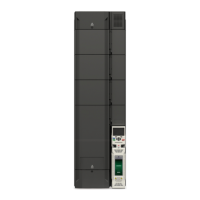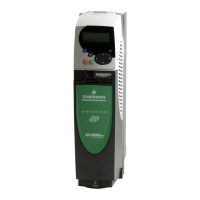Safety
information
Product
information
Mechanical
installation
Electrical
installation
Getting
started
Basic
parameters
Running
the motor
Optimization
NV Media Card
Operation
Onboard
PLC
Advanced
parameters
Technical
data
Diagnostics
UL listing
information
Unidrive M702 User Guide 129
Issue Number: 3
Ke is the ratio between r.m.s. line to line voltage produced by the motor
and the speed in V/1000 rpm. Care must also be taken not to de-
magnetize the motor. The motor manufacturer should always be
consulted before using this mode.
8.6.4 Maximum speed / frequency
In all operating modes (Open loop, RFC-A and RFC-S) the maximum
output frequency is limited to 550 Hz. However, in RFC-S mode the
speed is also limited by the voltage constant (Ke) of the motor. Ke is a
specific constant for the servo motor being used. It can normally be
found on the motor data sheet in V/k rpm (volts per 1,000 rpm).
8.6.5 Quasi-Square wave (open-loop only)
The maximum output voltage level of the drive is normally limited to an
equivalent of the drive input voltage minus voltage drops within the drive
(the drive will also retain a few percent of the voltage in order to maintain
current control). If the motor rated voltage is set at the same level as the
supply voltage, some pulse deletion will occur as the drive output voltage
approaches the rated voltage level. If Pr 05.020 (Quasi-square wave
enable) is set to 1 the modulator will allow over modulation, so that as
the output frequency increases beyond the rated frequency the voltage
continues to increase above the rated voltage. The modulation depth will
increase beyond unity; first producing trapezoidal and then quasi-square
waveforms.
This can be used for example:
• To obtain high output frequencies with a low switching frequency
which would not be possible with space vector modulation limited to
unity modulation depth,
or
• In order to maintain a higher output voltage with a low supply
voltage.
The disadvantage is that the machine current will be distorted as the
modulation depth increases above unity, and will contain a significant
amount of low order odd harmonics of the fundamental output frequency.
The additional low order harmonics cause increased losses and heating
in the motor.

